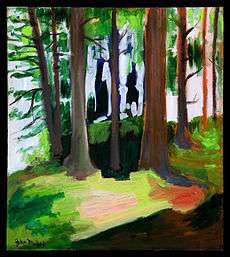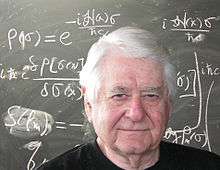John Moffat (physicist)
| John Moffat | |
|---|---|
|
Moffat in 2007 | |
| Born |
1932 (age 83–84) Copenhagen, Denmark |
| Residence | Denmark, United Kingdom, Canada |
| Fields | Physics |
| Institutions |
University of Toronto Perimeter Institute for Theoretical Physics, Waterloo |
| Alma mater | Trinity College, Cambridge |
| Doctoral advisor | Fred Hoyle and Abdus Salam |
| Doctoral students |
Robert Bruce Mann Gabor Kunstatter Dwight Vincent |
| Known for |
Gravitation Quantum field theory Variable speed of light |
John W. Moffat (b. 12 Oct 1932)[1] is a Professor Emeritus in physics at the University of Toronto.[2] He is also an adjunct Professor in physics at the University of Waterloo and a resident affiliate member of the Perimeter Institute for Theoretical Physics.
Moffat is best known for his work on gravity and cosmology, culminating in his nonsymmetric gravitational theory and scalar–tensor–vector gravity (now called MOG), and summarized in his 2008 book for general readers, Reinventing Gravity. His theory explains galactic rotation curves without invoking dark matter. He proposes a variable speed of light approach to cosmological problems, which posits that G/c is constant through time, but G and c separately have not been. Moreover, the speed of light c may have been more than 30 orders of magnitude higher during the early moments of the Big Bang. His recent work on inhomogeneous cosmological models purports to explain certain anomalous effects in the CMB data, and to account for the recently discovered acceleration of the expansion of the universe.
Moffat has proposed a new nonlocal variant of quantum field theory, that is finite at all orders and hence dispenses with renormalization. It also generates mass without a Higgs mechanism.
Early career

Moffat began life as a struggling artist, but gave up after living for a time in Paris with no income. Upon returning to Copenhagen, Denmark, he became interested in the cosmos and began teaching himself mathematics and physics. He made such quick progress that within a year he began working on problems of general relativity and unified field theory.
"When I was about 20, I wrote a letter to Albert Einstein telling him that I was working on one of his theories. In 1953 Einstein sent me a reply, from Princeton, New Jersey, but it was written in German. So I ran down to my barber shop (in Copenhagen) to have my barber translate it for me. Through that summer and fall, we exchanged about a half dozen letters. The local press picked up on these stories which then caught the attention of physicist Niels Bohr and others. Suddenly doors of opportunity were swinging open for me". (Perimeter Institute for Theoretical Physics, 2005)
In 1958, he was awarded a Ph.D. without a first degree at Trinity College, Cambridge. (He was supervised by Fred Hoyle and Abdus Salam.)
"Dear Professor . . . I would be eternally indebted if you could find time to read my work," he began.
"Most honorable Mr. Moffat: Our situation is the following. We are standing in front of a closed box which we cannot open, and we try hard to discuss what is inside and what is not," Einstein replied.
During a career that spans over five decades, Moffat worked on a variety of subjects in Theoretical Physics. These include particle physics, quantum field theory, quantum gravity and cosmology.
Variable speed of light: theory and controversy
In 1992, John Moffat proposed that the speed of light was much larger in the early universe, in which the speed of light was 1030 times faster than its current value.[2] He published his "variable speed of light" (VSL) theory in two places—on the Los Alamos National Laboratory's (LANL) online archive, Nov. 16, 1992,[3] and in a 1993 edition of International Journal of Modern Physics D.[4][5]
The scientific community mostly ignored VSL theory[4] until in 2001, University of New South Wales astronomer John Webb and peers detected experimental evidence from telescopic observations that the cosmological fine structure constant—which contains the speed of light—may have been different than its present value in the very early Universe.[6]
The observations supported Moffat's VSL theory—and started a race for primacy that began in 1998.
That year, five years after Moffat had published his VSL papers, João Magueijo of Imperial College in London, and collaborators Andrew Albrecht of the University of California at Davis and John D. Barrow of Cambridge University, published a strikingly similar idea in the more prestigious journal, Physical Review D, which had rejected Moffat's paper years earlier.[2]
Informed of the omission, Magueijo credited Moffat with an entire chapter in Magueijo's 2002 book, Faster Than the Speed of Light: The story of a scientific speculation.[2][7]
The controversy reignited, however, when during a worldwide publicity tour for Magueijo's book, the author neither credited Moffat nor corrected numerous erroneous press accounts—in such magazines as Discover,[8] Publisher's Weekly,[9] Seed Magazine and the Christian Science Monitor.[10] In efforts to portray Magueijo as a "brash, young scientific upstart," dozens of publications attributed VSL theory entirely to Magueijo and his co-authors, leaving Moffat—in his late sixties by this time—out.[4][5] Moffat expressed displeasure about the re-emergent omissions, urging reporters to check their facts, but to no avail.[4][5]
Stories emerged about the book tour media omissions in March and July 2003, written by a science journalist, Michael Martin, who had earlier attributed VSL theory to Moffat in a 2001 UPI article about Webb's astronomical discoveries.[11] Discover Magazine writer Tim Folger acknowledged the omissions in his story and apologized. In response to a reader letter from Henry van Driel of the University of Toronto Department of Physics, Folger wrote, "Professor van Driel is absolutely right—John Moffat did develop a varying speed of light theory several years before João Magueijo, and I regret not including that information in my story."[12]
Months later, as other reports picked up on the reignited dispute,[13] Magueijo reiterated Moffat's primacy in VSL theory.[4][5] In September 2004, Discover Magazine's Tim Folger followed through on a promise he had made during the controversy to "write a story about John Moffat.".[14]
The two physicists eventually settled their differences and became friends, publishing a joint paper in 2007 in the journal General Relativity and Gravitation.[15]
French astrophysicist Jean-Pierre Petit, a senior researcher at the National Center for Scientific Research, published an earlier 1988 theory involving variable speed of light in the journal Modern Physics Letters A.[16]
Modified gravity theory
Continuing Einstein's search for a unified field theory, Moffat proposed a nonsymmetric gravitational theory that, like Einstein's unified field, incorporated a symmetric field (gravity) and an antisymmetric field. Unlike Einstein, however, Moffat made no attempt to identify the latter with electromagnetism, instead proposing that the antisymmetric component is another manifestation of gravity. As investigation progressed, the theory evolved in a variety of ways; most notably, Moffat postulated that the antisymmetric field may be massive.
The current version of his modified gravity (MOG) theory, which grew out of this investigation, modifies Einstein's gravity with the addition of a vector field, while also promoting the constants of the theory to scalar fields. The combined effect of these fields modifies the strength of gravity at large distances when large masses are involved, successfully accounting for a range of astronomical and cosmological observations. The resulting theory describes well, without invoking dark matter, the rotation curves of galaxies[17] and the mass profiles of X-ray galaxy clusters.[18]
Non-local quantum field theory
In 1990, Moffat proposed a finite, non-local quantum field theory. The theory was developed extensively by Evens, Moffat, Kleppe and Woodard in 1991. In subsequent work, Moffat proposed this theory as an alternative to the standard electroweak unification of electromagnetism and the weak nuclear interactions. Moffat's theory is a quantum field theory with a non-local term in the field Lagrangian. The theory is gauge invariant and it is finite to all orders of perturbation theory. For the standard model it can solve the Higgs boson mass hierarchy naturalness problem.[19] It also leads to a finite quantum gravity theory.
Publications
Books
- Reinventing Gravity. HarperCollins. 2008. ISBN 0-06-117088-7.
- Einstein Wrote Back. Thomas Allen Publishers. 2010. ISBN 978-0-88762-615-9.
- Cracking the Particle Code of the Universe: The Hunt for the Higgs Boson. Oxford University Press. 2014. ISBN 978-0-19-991552-1.
Selected articles
- (1990) "Finite nonlocal gauge field theory," Phys. Rev. D 41: 1177-1184.
- (1993) "Superluminary Universe: A Possible Solution to the Initial Value Problem in Cosmology," Int. Jour. Mod. Phys. D2: 351-366.
- (1995) "Nonsymmetric Gravitational Theory," Phys. Lett. B 355: 447-452.
- (2006) "Scalar-Tensor-Vector Gravity Theory," JCAP 0603: 004.
See also
References
- ↑ "Birthdays". The Guardian (Guardian News & Media). 11 Oct 2014. p. 55.
- 1 2 3 4 Peter Calamai (27 November 2005). "Einstein's respectful heretic". Toronto Star. Retrieved 21 May 2011.
- ↑ J.W. Moffat Superluminary Universe: A Possible Solution to the Initial Value Problem in Cosmology
- 1 2 3 4 5 Michael Martin (24 March 2003)"In From the Cold: A Toronto physicist's once-ridiculed theory gains acceptance" Maclean's
- 1 2 3 4 Michael Martin (1 July 2003) "In the Shadow of the Speed of Light" St. Louis Journalism Review
- ↑ J.K. Webb, M.T. Murphy, V.V. Flambaum, V.A. Dzuba, J.D. Barrow, C.W. Churchill, J.X. Prochaska and A.M. Wolfe (2001). "Further Evidence for Cosmological Evolution of the Fine Structure Constant". Phys. Rev.Lett. 87 (9): 091301. arXiv:astro-ph/0012539. Bibcode:2001PhRvL..87i1301W. doi:10.1103/PhysRevLett.87.091301. PMID 11531558. line feed character in
|journal=at position 6 (help) arXiv:astro-ph/0012539 - ↑ Smolin, Lee (2006). The trouble with physics. Mariner Books. p. 230. ISBN 978-0-618-91868-3. Retrieved 21 May 2011.
- ↑ Tim Folger (April, 2003) "Was Einstein Wrong?" Discover Magazine
- ↑ Judith Rosen (1 January 2003) "Physics Brat: First-time author takes on Einstein" Publisher's Weekly
- ↑ Lori Valigra (30 January 2003) "New theory on light weighs heavily on scientists: A brash young theoretical physicist claims Einstein was wrong" Christian Science Monitor
- ↑ Michael Martin (17 August 2001) "That Speed of Light Varies Long Suspected" United Press International
- ↑ Reader Letters (June 2003) Discover Magazine
- ↑ Dan Falk (Nov. 08, 2003) "Maverick Physicist" Toronto Globe and Mail
- ↑ Tim Folger (Sept. 4, 2004) "Einstein's Grand Quest for a Unified Theory" Discover Magazine
- ↑ J.W. Moffat, J. Magueijo "Comments on "Note on varying speed of light theories"
- ↑ Petit, Jean-Pierre (June 1988). "An Interpretation of Cosmological Model with Variable Light Velocity". Modern Physics Letters A 3 (16): 1527–1532. Bibcode:1988MPLA....3.1527P. doi:10.1142/S0217732388001823.
- ↑ J. W. Moffat, S. Rahvar, The MOG weak field approximation and observational test of galaxy rotation curves; arXiv:1306.6383
- ↑ arXiv:1309.5077
- ↑ J. W. Moffat, Beyond The Standard Model; arxiv:hep-ph/9802228
External links
| Wikiquote has quotations related to: John Moffat (physicist) |
University of Toronto press releases re Moffat:
- 1999
- 2003
- 2007
- Review of Reinventing Gravity at Amazon.com.
- John Moffat at the Mathematics Genealogy Project
|
